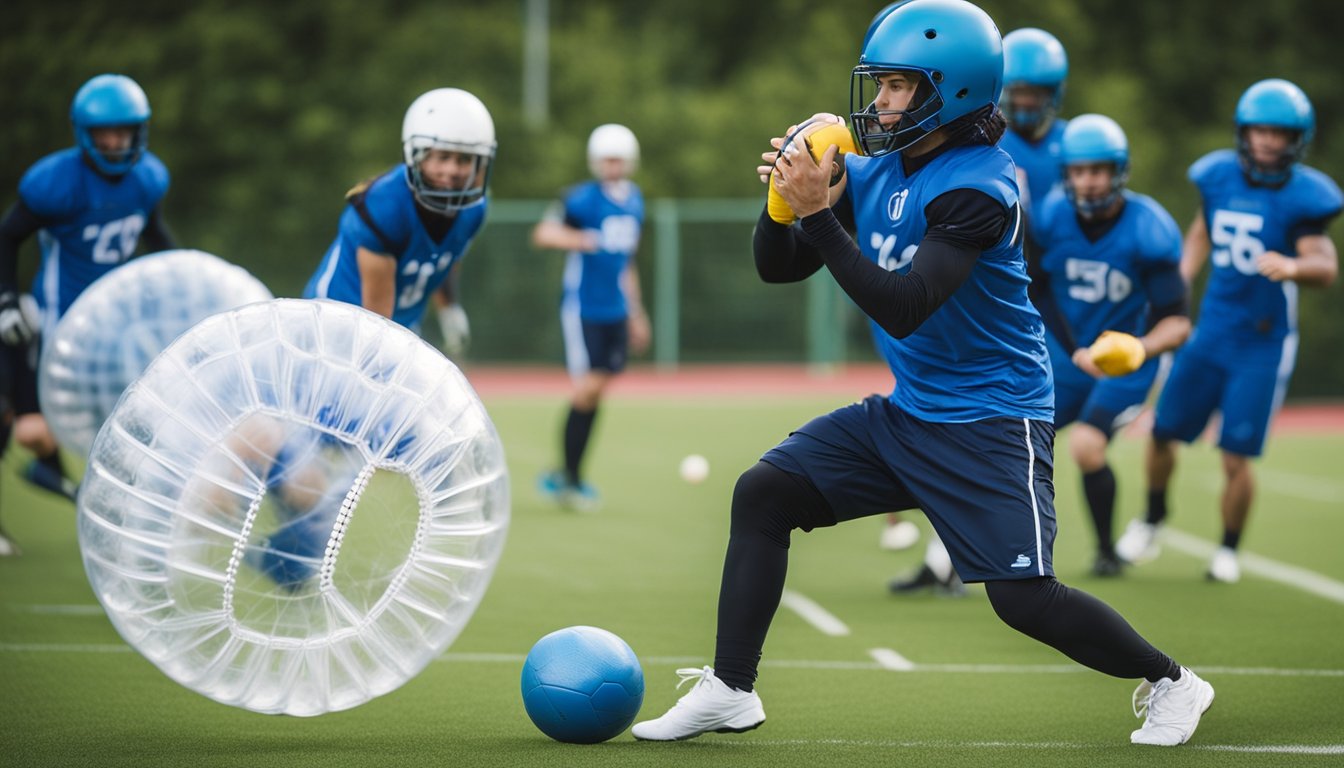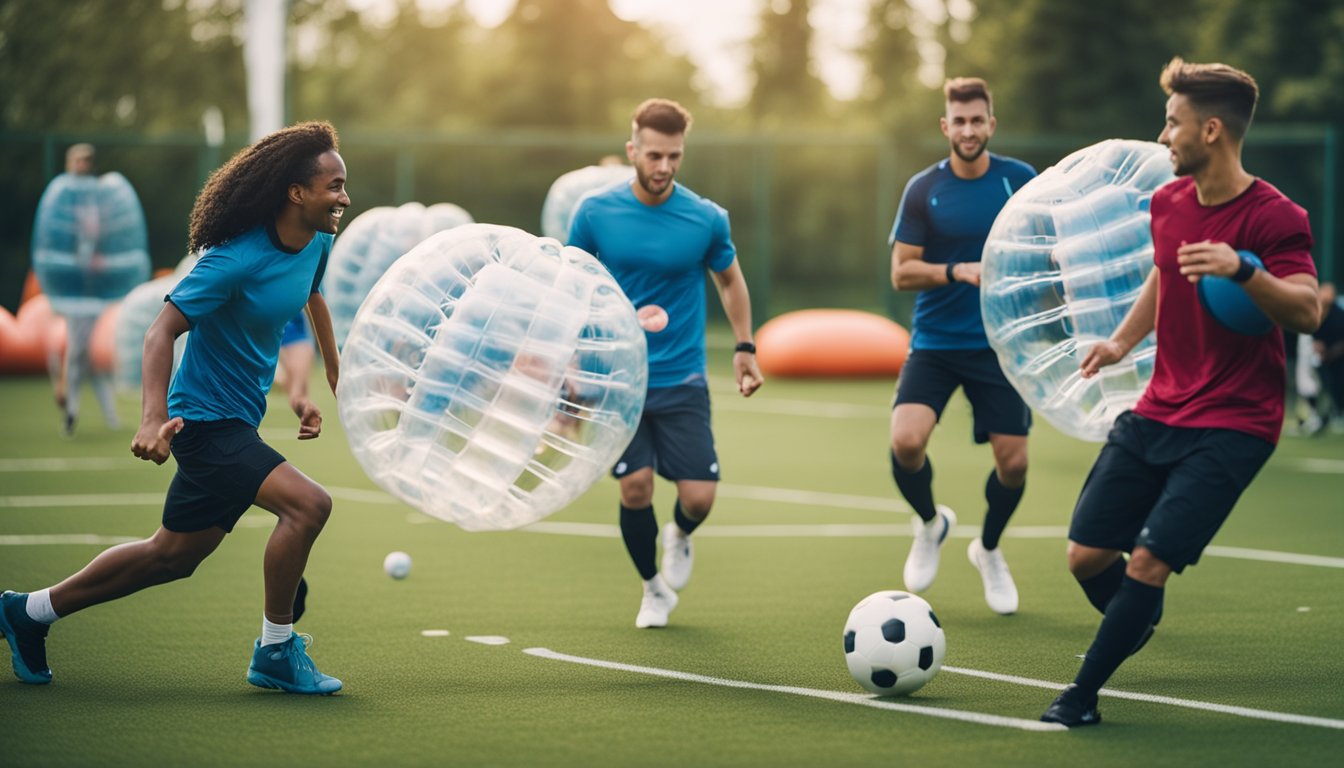Late updated: 12 Aug 2024 09:08
Written by: Emma Saunders
Bubble Football Injury Prevention Tips: Essential Safety Measures
Building camaraderie and having fun both go hand-in-hand when playing bubble football. However, ensuring everyone's safety on the pitch is paramount. Bubble football is inherently physical, with all the bouncing and rolling contributing to its whimsical nature. Understanding how to prevent injuries will not only keep the game fun but also safe for everyone involved.

Football injury prevention starts with proper warm-up exercises. Cold, stiff muscles are more prone to injury, making a comprehensive 20-minute warm-up routine essential. Equipping oneself with the correct gear is also crucial. Always wear full, proper equipment to minimise risks associated with the sport.
Warm-ups, correct gear, and best practices are integral for safe bubble football. Following these measures allows players to engage in the game with minimal concerns about potential injuries, focusing instead on teamwork and having a blast.
Key Takeaways
- Always warm up before playing to prevent injuries.
- Wear appropriate and full equipment for safety.
- Follow safety guidelines to enjoy the game without worries.
Understanding the Risks and Equipment

When engaging in bubble football, players face various injury risks that can be mitigated through proper use of protective gear. Recognising common injuries and selecting the right equipment are critical for ensuring safety and enjoyment of the game.
Identifying Common Injuries in Bubble Football
Common injuries in bubble football include concussions, knee injuries, and ankle sprains. The nature of the game, which involves frequent collisions and high-energy rebounds, increases the risk of head injuries. Knees are vulnerable because of sudden changes in direction, while ankles can be sprained due to unstable landings. Fractures can also occur from heavy impacts, despite the cushioning effect of the bubbles.
Choosing Proper Equipment for Safety
Ensuring safety in bubble football requires selecting the right equipment. Bubble suits, also known as zorbs, are essential, as they envelop the upper body and head, significantly reducing impact forces. Helmets can provide additional head protection, especially in more aggressive matches. Wearing mouthguards helps prevent dental injuries, while shoulder pads shield the upper body from direct hits. Proper cleats are crucial for stability, offering better grip and support on the playing surface to prevent slips and ankle sprains.
The Role of Protective Gear in Injury Prevention
Protective gear is fundamental in minimizing injury risks. Using well-maintained and correctly fitted gear can enhance safety.
Bubble suits act as the primary defence, absorbing much of the impact during collisions. Helmets and mouthguards ensure head and dental safety, while shoulder pads distribute the force of hits more evenly across the body. Effective cleats enhance traction, helping to prevent falls and providing ankle support. Combining these elements significantly lowers the injury risk, making bubble football a safer and more enjoyable experience for all players.
Preventative Measures and Best Practices
In bubble football, injury prevention is critical for ensuring safety and maximising enjoyment. This involves a combination of conditioning, proper nutrition, hydration, and rest.
Incorporating Regular Conditioning and Strength Training
Regular conditioning and strength training are essential for reducing the risk of injuries in bubble football. By focusing on exercises that enhance muscle strength, flexibility, and endurance, we improve overall physical preparation.
Strength training targets specific muscle groups used in bubble football, such as the legs, core, and upper body. This includes squats, lunges, and planks.
Incorporating dynamic exercises such as agility drills and speed training helps in developing agility and quick reflexes, essential for the rapid movements in bubble football. Adopting a balanced training routine that includes both strength and conditioning is paramount.
Effective Warm-Up and Cool-Down Techniques
Warming up before playing bubble football prepares the body for the intense physical activity. It helps in preventing injuries by increasing blood flow to the muscles, enhancing flexibility, and reducing muscle stiffness.
An effective warm-up routine should last at least 15-20 minutes and include activities such as light jogging, dynamic stretches, and specific drills related to the sport.
Post-game, the cool-down process is equally important to gradually decrease the heart rate and prevent muscle soreness. This should involve static stretching and light aerobic activities, like walking, to help relax the muscles.
Strategies for Adequate Hydration and Nutrition
Proper hydration and nutrition are fundamental in preventing overuse injuries and maintaining optimal performance in bubble football. Drinking water regularly throughout the day, and especially before, during, and after the game, helps in avoiding dehydration which can lead to fatigue and decreased concentration.
Nutrition plays a crucial role in muscle repair and energy replenishment. Consuming balanced meals rich in carbohydrates, proteins, and healthy fats supports sustained energy levels. Pre-game snacks like fruits or energy bars can provide a quick energy boost, while post-game meals should focus on protein for muscle recovery.
Implementing Rest and Recovery in Training
Rest and recovery are vital components of an effective injury prevention strategy. Overtraining and insufficient rest can lead to fatigue and overuse injuries.
Implementing scheduled rest days allows muscles to recover and rebuild, preventing burnout and enhancing performance. Techniques such as foam rolling, massage, and adequate sleep are essential in the recovery process.
Listening to our bodies and recognising signs of fatigue or pain is critical. This helps us to adjust the training intensity accordingly, ensuring long-term health and performance in bubble football.
Frequently Asked Questions

Navigating the safety aspects of bubble football is essential for ensuring a fun and injury-free experience. Here, we address common concerns and provide practical tips for minimising risks.
How can one minimise the risk of injury while playing bubble football?
Minimising risk involves proper warm-ups, using quality bubble suits, and adhering to game rules. Stretching exercises help prevent muscle strains. Ensuring that the bubble suits are intact and in good condition is also crucial for safety. Encouraging fair play and following game guidelines can reduce accidents.
What safety measures should be taken for children participating in bubble football?
For children, supervision is key. Always have adults or trained professionals overseeing the activities. The use of age-appropriate bubble suits is necessary for proper fit and protection. Before each game, check the playing area for any hazards that could cause injury.
Which protective gear is essential for playing bubble football?
While the bubble suit provides considerable protection, additional gear can enhance safety. Players might consider wearing knee and elbow pads to safeguard against minor injuries. Comfortable, closed-toe shoes with good traction are essential to prevent slips and falls during the game.
What are the best practices for ensuring safety during zorb football matches?
Regular equipment checks are a must before each match. Ensure the playing field is free from debris and obstacles. Establish clear rules and make sure all players are aware of them. Encourage players to communicate with each other to avoid collisions.
How does the design of bubble balls contribute to player safety?
Bubble balls are designed to encase the upper body, leaving legs free for movement. This design helps to absorb impact during falls or collisions, thus reducing the risk of injury. The material used is generally durable and can cushion the body effectively against shocks.
What should organisers consider to prevent accidents in bubble football events?
Organisers should ensure that all equipment is in good repair and suitable for the players' age and size. Providing a safe, clean playing environment is fundamental. Adequate briefing on safety protocols and having first aid kits on hand can make a significant difference in preventing and managing any injuries.
